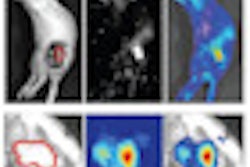Childhood cancer survivors whose treatment included abdominal radiotherapy (RT) have an increased risk of developing diabetes. Now, a study published online August 23 in Lancet Oncology has narrowed the location of radiation dose vulnerability to the tail of the pancreas.
A French and U.K. research team used the medical records of the French Childhood Cancer Survivor Study (FCCSS) and the British Cancer Survivor Study (BCCSS) to identify patients who had been treated for a solid cancer or lymphoma between 1985 and 1995. They then sent questionnaires to these survivors, and used the responses and the information about radiotherapy treatment in the medical records to investigate the relationship between radiation dose to the pancreas and the risk of a subsequent diabetes diagnosis.
The researchers determined that the risk of developing adult diabetes strongly increased with rising radiation dose to the tail of the pancreas, where the islets of Langerhans are principally located. (The islets of Langerhans are groups of specialized cells that make and secrete hormones, including the beta cell, which produces insulin.)
Patients who received an average radiation dose of 24.2 Gy to the tail of the pancreas were 12.6 times more likely to be diagnosed with diabetes within 20 years following treatment compared with patients who did not receive radiation therapy.
Using the two childhood cancer survivor databases, the reearchers identified a total of 4,285 patients who had received treatment at one of eight cancer treatment centers in France and the U.K. By 2010, when the study was initiated, 728 patients had died and 545 were lost to follow-up. An additional 89 patients were excluded because they did not meet the eligibility requirements for the study.
The research team mailed questionnaires to the remaining 2,923 survivors and had a 72.7% response rate. A total of 95 individuals reported that they had diabetes. This condition was confirmed for 65 of the patients by their physicians. Sixty of these cancer survivors with diabetes had received radiotherapy treatments.
Of the 2,520 respondents, 65% had received radiotherapy treatments, and radiation dose was estimated to the tail, body, and head of the pancreas for each of these patients, as well as doses for other body organs and at 91 skeletal sites. Lead author Dr. Florent de Vathaire, of the radiation epidemiology group at the Institut National de la Santé et de la Recherche Médicale in Villejuif, France, and co-authors calculated dosimetric estimations by reconstruction of the radiation therapy condition from the patient's medical records or for typical treatment in cases in which this information was missing.
Findings
The mean radiation dose to the body of the pancreas was 12.0 Gy and 8.8 Gy to the tail for the 1,632 patients who received radiotherapy. The researchers determined that the relative risk of diabetes was 11.5 times greater for patients who received 10 Gy or more to the tail of the pancreas, and the risk increased as the dose increased up to 20-29 Gy, after which it plateaued.
The type of cancer a patient had was associated with the incidence of diabetes among this patient cohort. At age 45, nephroblastoma survivors had a cumulative incidence of 14.7%, compared with 3.1% for survivors of other cancers.
Sex, date of treatment, and country of treatment had no significance, nor did body mass index. Patients who were overweight or obese had received higher radiation dose to the pituitary gland and lower radiation dose to the body of the pancreas than the rest of the radiation therapy recipients, the researchers reported.
They also determined that a young age at the time of radiotherapy was a significant dose response modifier for survivors with noninsulin-dependent diabetes but not for insulin-dependent diabetes. However, radiation dose received by other organs did not play any part, nor did any chemotherapy treatment that was received.
"Until now, the pancreas was one of the few organs not considered at risk of normal tissue complication in the French and the United Kingdom national guidelines for cancer radiation therapy. Our findings emphasize the need to test for glucose tolerance in all patients with a history of abdominal radiation therapy to enable the early detection of diabetes," they concluded.
The researchers also emphasized the need to contour the pancreas when planning radiation therapy treatments so that it would receive as low a dose as could be achieved. Long-term follow-up of survivors also is important.
Commentary
In an accompanying commentary, Dr. Kevin Oeffinger and Dr. Charles Sklar, directors of the long-term follow-up programs at Memorial Sloan-Kettering Cancer Center, commended the team for its research, noting that they added "one more piece in the puzzle" of the correlation between abdominal radiation and adult diabetes that was first identified in 1995.
In communications with AuntMinnie.com, Oeffinger agreed with the concern expressed by the authors that although radiotherapy technology has made treatments more precise with respect to their targets, doses and dose rates have not substantially changed since this time.
"Theoretically, newer radiation modalities, such as intensity-modulated radiation therapy (IMRT) or proton radiation therapy, may lessen the risk of diabetes if less surrounding normal tissue is exposed to radiation. However, until studies are conducted on patients treated with these modalities, we will not know if the risk is different," he said.
This is a matter of waiting at least 20 years after treatment. Memorial Sloan-Kettering follows its pediatric cancer survivors throughout their lifetime, now using an Internet-accessed electronic patient portal as well as more conventional means of communication to monitor conditions and advise them of laboratory tests and clinical checkups that are due.
Oeffinger and Sklar also recommended that studies be undertaken to clarify the mechanisms underlying diabetes after abdominal radiation, so that targeted interventions can be developed that will reduce risk. The cancer center has not yet developed any targeted interventions, but is in the process of developing a method to screen for diabetes in this group, Oeffinger said.



















